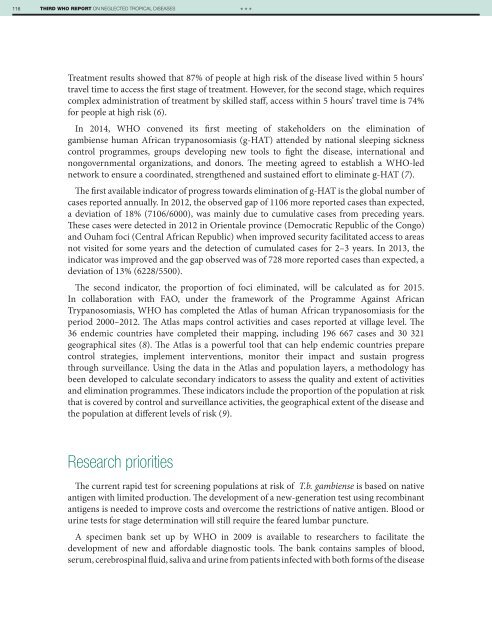1A9bnbK
1A9bnbK
1A9bnbK
Create successful ePaper yourself
Turn your PDF publications into a flip-book with our unique Google optimized e-Paper software.
116 THIRD WHO REPORT ON NEGLECTED TROPICAL DISEASES<br />
***<br />
Treatment results showed that 87% of people at high risk of the disease lived within 5 hours’<br />
travel time to access the first stage of treatment. However, for the second stage, which requires<br />
complex administration of treatment by skilled staff, access within 5 hours’ travel time is 74%<br />
for people at high risk (6).<br />
In 2014, WHO convened its first meeting of stakeholders on the elimination of<br />
gambiense human African trypanosomiasis (g-HAT) attended by national sleeping sickness<br />
control programmes, groups developing new tools to fight the disease, international and<br />
nongovernmental organizations, and donors. The meeting agreed to establish a WHO-led<br />
network to ensure a coordinated, strengthened and sustained effort to eliminate g-HAT (7).<br />
The first available indicator of progress towards elimination of g-HAT is the global number of<br />
cases reported annually. In 2012, the observed gap of 1106 more reported cases than expected,<br />
a deviation of 18% (7106/6000), was mainly due to cumulative cases from preceding years.<br />
These cases were detected in 2012 in Orientale province (Democratic Republic of the Congo)<br />
and Ouham foci (Central African Republic) when improved security facilitated access to areas<br />
not visited for some years and the detection of cumulated cases for 2–3 years. In 2013, the<br />
indicator was improved and the gap observed was of 728 more reported cases than expected, a<br />
deviation of 13% (6228/5500).<br />
The second indicator, the proportion of foci eliminated, will be calculated as for 2015.<br />
In collaboration with FAO, under the framework of the Programme Against African<br />
Trypanosomiasis, WHO has completed the Atlas of human African trypanosomiasis for the<br />
period 2000–2012. The Atlas maps control activities and cases reported at village level. The<br />
36 endemic countries have completed their mapping, including 196 667 cases and 30 321<br />
geographical sites (8). The Atlas is a powerful tool that can help endemic countries prepare<br />
control strategies, implement interventions, monitor their impact and sustain progress<br />
through surveillance. Using the data in the Atlas and population layers, a methodology has<br />
been developed to calculate secondary indicators to assess the quality and extent of activities<br />
and elimination programmes. These indicators include the proportion of the population at risk<br />
that is covered by control and surveillance activities, the geographical extent of the disease and<br />
the population at different levels of risk (9).<br />
Research priorities<br />
The current rapid test for screening populations at risk of T.b. gambiense is based on native<br />
antigen with limited production. The development of a new-generation test using recombinant<br />
antigens is needed to improve costs and overcome the restrictions of native antigen. Blood or<br />
urine tests for stage determination will still require the feared lumbar puncture.<br />
A specimen bank set up by WHO in 2009 is available to researchers to facilitate the<br />
development of new and affordable diagnostic tools. The bank contains samples of blood,<br />
serum, cerebrospinal fluid, saliva and urine from patients infected with both forms of the disease


